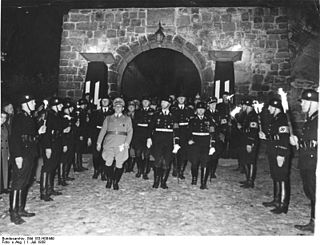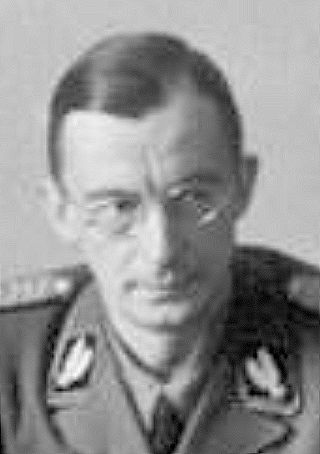
In Nazi German terminology, Volksdeutsche were "people whose language and culture had German origins but who did not hold German citizenship". The term is the nominalised plural of volksdeutsch, with Volksdeutsche denoting a singular female, and Volksdeutscher, a singular male. The words Volk and völkisch conveyed the meanings of "folk".

The Heim ins Reich was a foreign policy pursued by Adolf Hitler before and during World War II, beginning in 1938. The aim of Hitler's initiative was to convince all Volksdeutsche who were living outside Nazi Germany that they should strive to bring these regions "home" into Greater Germany, but also relocate from territories that were not under German control, following the conquest of Poland, in accordance with the Nazi–Soviet pact. The Heim ins Reich manifesto targeted areas ceded in Versailles to the newly reborn state of Poland, various lands of immigration, as well as other areas that were inhabited by significant ethnic German populations, such as the Sudetenland, Danzig, and the southeastern and northeastern regions of Europe after 6 October 1939.

Gottlob Christian Berger was a senior German Nazi official who held the rank of SS-Obergruppenführer und General der Waffen-SS and was the chief of the SS Main Office responsible for Schutzstaffel (SS) recruiting during World War II. At the post-war Nuremberg trials, the Waffen-SS – within which Berger was a senior officer – was declared to be a criminal organisation due to its major involvement in war crimes and crimes against humanity. Berger was convicted as a war criminal and spent six and a half years in prison.

Arthur Karl Greiser was a Nazi German politician, SS-Obergruppenführer, Gauleiter and Reichsstatthalter of the German-occupied territory of Wartheland. He was one of the persons primarily responsible for organizing the Holocaust in occupied Poland and numerous other crimes against humanity. He was arrested by the Americans in 1945, and was tried, convicted and executed by hanging in Poland in 1946 for his crimes, most notably genocide.

The Reich Security Main Office was an organization under Heinrich Himmler in his dual capacity as Chef der Deutschen Polizei and Reichsführer-SS, the head of the Nazi Party's Schutzstaffel (SS). The organization's stated duty was to fight all "enemies of the Reich" inside and outside the borders of Nazi Germany.

The Allgemeine SS was a major branch of the Schutzstaffel (SS) paramilitary forces of Nazi Germany; it was managed by the SS Main Office (SS-Hauptamt). The Allgemeine SS was officially established in the autumn of 1934 to distinguish its members from the SS-Verfügungstruppe, which later became the Waffen-SS, and the SS-Totenkopfverbände, which were in charge of the Nazi concentration camps and extermination camps. SS formations committed many war crimes against civilians and allied servicemen.

The RuSHA trial was a trial against 14 SS officials charged with implementing Nazi racial policies.

Werner Lorenz was an SS functionary during the Nazi era. He was head of the Volksdeutsche Mittelstelle (VOMI), an organization charged with resettling ethnic Germans in the "German Reich" from other parts of Europe, as well as colonising the occupied lands during World War II. After the war, Lorenz was sentenced to prison for crimes against humanity in 1948. He was released in 1954 and died in 1974.

The Deutsche Volksliste, a Nazi Party institution, aimed to classify inhabitants of Nazi-occupied territories (1939–1945) into categories of desirability according to criteria systematised by Reichsführer-SS Heinrich Himmler. The institution originated in occupied western Poland. Similar schemes were subsequently developed in Occupied France (1940–1944) and in the Reichskommissariat Ukraine (1941–1944).

The SS Race and Settlement Main Office was the organization responsible for "safeguarding the racial 'purity' of the SS" within Nazi Germany.

Erhard Kroeger or Kröger was a Baltic German SS officer involved in the resettlement of Baltic Germans before World War II. He commanded an Einsatzgruppe in 1941, and was later attached to General Andrey Vlasov and the German sponsored Russian Liberation Army of World War II. He was convicted of war crimes in 1969.
Units and commands of the Schutzstaffel were organizational titles used by the SS to describe the many groups, forces, and formations that existed within the SS from its inception in 1923 to the eventual fall of Nazi Germany in 1945.

The August Frank memorandum of 26 September 1942 was a directive from SS Lieutenant General August Frank of the SS concentration camp administration department (SS-WVHA). The memorandum provides a measure of the detailed planning that Frank and other Nazis put into the carrying out of the Holocaust. It includes instructions as to the disposition of postage stamp collections and underwear of the murdered Jews. It is clear that the Nazis were intent in removing everything of value from their victims.

Josef "Sepp" Janko was a Volksgruppenführer of the Danube Swabian German Cultural Association in Yugoslavia in 1939, and later was appointed SS Obersturmführer during World War II.

Branimir Altgayer was a German minority leader in the Kingdom of Yugoslavia and the Independent State of Croatia, and an SS officer in World War II.

Richard Hermann Hildebrandt was a German Nazi politician and SS-Obergruppenführer. During the Second World War, he served as a Higher SS and Police Leader (HSSPF) in Nazi-occupied Poland, the Soviet Union and the Protectorate of Bohemia and Moravia. He was the last head of the SS Race and Settlement Main Office in SS headquarters, charged with enforcing Germanization policies. After the war, Hildebrandt was convicted of war crimes and crimes against humanity by an American military court and sentenced to 25 years in prison. He was subsequently extradited to Poland to stand trial for separate charges, sentenced to death, and executed. Hildebrandt was the younger brother of Ernst-Albrecht Hildebrandt who was an SS-Oberführer and SS and Police Leader (SSPF) in northern Italy.

Hermann Johann Heinrich Behrends was a Nazi Party member and SS official with the rank of lieutenant general (Gruppenführer).

The Expulsion of Poles by Nazi Germany during World War II was a massive operation consisting of the forced resettlement of over 1.7 million Poles from the territories of German-occupied Poland, with the aim of their Germanization between 1939 and 1944.

Rudolf Creutz was an Austrian Nazi and a high-ranking member of the SS during World War II. He was involved in the implementation of racial resettlement programs in the Occupied Territories and was convicted of war crimes by the Allies in 1948.
Fritz Tittmann was a German Nazi politician and SS-Brigadeführer who served as an early Party leader in Saxony and, from 1941 to 1942, as SS and Police Leader in Nikolajew. He died near the end of the Second World War in unclear circumstances.























